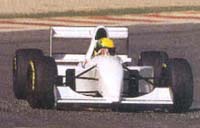McLaren's brief flirtation with the Chrysler empire
Author
- Rainer Nyberg
Date
- 8W Autumn 2001 issue
Related articles
- Ayrton Senna - The Toleman days, by Mattijs Diepraam
Who?Ayrton Senna What?McLaren-Chrysler (Lamborghini) MP4/8 Where?Estoril When?October 1993 |
 |
Why?
A McLaren-Lamborghini connection was first rumoured in August 1993. Italian papers stated that McLaren was building a car for Chrysler. The rumour was more than a rumour because a test car was actually being built. There seemed a possibility that the parent of Lamborghini, American giant Chrysler, wanted to expand their involvement in Formula 1.
The Mauro Forghieri designed Lamborghini V12 had been seen in Formula One since the 1989 season. Their initial partner had been Gerard Larrousse's team for 1989-90. For 1990 Team Lotus was also provided with Lamborghini motors. For 1991 they provided 'factory' support to the Modena Team. This team had taken over the remains of the Mexican-financed GLAS project. Ligier was also supplied with customer V12 engines for 1991, and for 1992 Larrousse was once again provided with Lamborghinis as were Minardi. Now Chrysler decals were also seen on the engine covers. An all-new, lighter engine was produced for 1993, with Larrousse remaining in the Chrysler-Lamborghini fold.
Unsure about the potential and speed of the Larrousse car, Chrysler approached McLaren for a test. Lamborghini and McLaren already had a link via TAG Electronics who provided engine management systems for Lamborghini during 1992-'93. The new-for-1993 engine was the smallest and lightest V12 ever and was admired by several other teams. A car was also converted to enable Chrysler to judge whether the Lambo V12 had any potential to be a winner in F1. Several Lamborghini V12 engines were supplied to the Ron Dennis-managed Marlboro McLaren team, that modified a MP4/8 to 'B' spec for the test.
The first test took place on Monday September 20, 1993 with Ayrton Senna behind the wheel of this all-white sponsorless test car at Silverstone. Frenchman François Castaing, was the Chrysler vice-president of vehicle engineering, was backing the test as Chrysler was keen to promote their new Neon range of cars for their European introduction. Of course McLaren would provide a higher profile partner than the little Larrousse team. In Honda fashion Chrysler also wanted to train their engineers in this high-tech area.
The first public test came at Estoril during October 1993. Ayrton Senna called the engine reliable and promising. He also said: "It is very good, but it needs more power and is not very sophisticated. I am sure it could be very good for next season." Fuelling rumours of racing the engine during the running season Senna also said: "It would be very interesting to race the Lamborghini in Japan." Ron Dennis quickly denied this and said that they had no plans to race to race the Chrysler-financed V12. During these McLaren tests the V12 was always called a Chrysler V12. Back at home McLaren test-driver Mika Häkkinen ran at Silverstone 1.4s faster than with the Ford-powered car. Buoyed by the result Chrysler promised an all-new V12 engine to McLaren for 1994.
Meanwhile, Peugeot also wanted to enter Formula 1 with a V10 derived from their Group C engine. In mid-October Gérard Larrousse was rumoured to be close to a deal when McLaren shocked everyone with the announcement that they had signed a deal with Peugeot for 1994. Chrysler PR director Tom Kowaleski commented: "We are disappointed to say the least. We have worked very hard in the last few months, including a very intense period recently putting together a team to interface with McLaren and TAG Electronics. The car was very quick and Ayrton Senna said some encouraging things about it. There was a strong agreement to proceed together for the future. The decision may say something about F1. It's no secret that the marque must look at its costs, and we wanted to introduce our lean and efficient approach to it."
Instead Larrousse got the Lamborghini V12 engine for 1994 and Lamborghini Engineering MD Daniele Audetto said they would receive full support. He also said that it would not be on the same level as it would have been had McLaren signed.
It never happened. In November 1993, having been so bitterly disappointed by McLaren, Chrysler sold Lamborghini to an Indonesian investor group led by Tommy, the playboy son of then president Suharto, and together with Chrysler the Lamborghini name disappeared from Formula 1. It put an end to a brief parenthesis in McLaren history.
The result would not be happy for any of the people and teams involved. Although armed with fresh support from French brewery Kronenbourg and their alcohol-free brand Tourtel, Larrousse had to take a customer Ford HB deal to replace the promised Lamborghini units. The team struggled throughout the 1994 season, resorting to pay drivers to keep their effort afloat, but still Larrousse called it a day at season's end.
At McLaren, the Peugeot deal was not enough to keep Ayrton Senna happy. With Häkkinen and Brundle, McLaren endured one of their worst seasons since Ron Dennis took over before ditching Peugeot in favour of Mercedes-Benz. Senna, meanwhile, signed for Frank Williams in the hope to revive the promise that he had made back in 1983. He was never allowed to.
